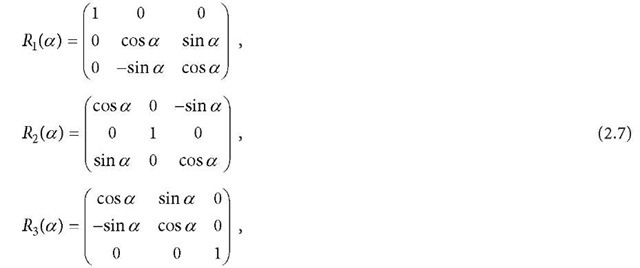Any Cartesian coordinate system can be transformed to another Cartesian coordinate system through three succeeded rotations if their origins are the same and if they are both right-handed or left-handed coordinate systems. These three rotational matrices are:
where a is the rotating angle, which has a positive sign for a counter-clockwise rotation as viewed from the positive axis to the origin.![]() are called the rotating matrix around the x, y, and z-axis, respectively. For any rotational matrix R, there are
are called the rotating matrix around the x, y, and z-axis, respectively. For any rotational matrix R, there are![]() that is, the rotational matrix is an orthogonal one, where R-1 and RT are the inverse and transpose of the matrix R.
that is, the rotational matrix is an orthogonal one, where R-1 and RT are the inverse and transpose of the matrix R.
For two Cartesian coordinate systems with different origins and different length units, the general transformation can be given in vector (matrix) form as
where![]() is the scale factor (or the ratio of the two length units), and R is a transformation matrix that can be formed by three suitably succeeded rotations.
is the scale factor (or the ratio of the two length units), and R is a transformation matrix that can be formed by three suitably succeeded rotations.![]() denote the new and old coordinates, respectively;
denote the new and old coordinates, respectively;![]() denotes the translation vector and is the coordinate vector of the origin of the old coordinate system in the new one.
denotes the translation vector and is the coordinate vector of the origin of the old coordinate system in the new one.
If rotational angle a is very small, then one has sin a~ a and cos a~ 0. In such a case, the rotational matrix can be simplified.
where a1, a2, a3 are small rotating angles around the x, y and z-axis, respectively. Using the simplified R, the transformation 2.8 is called the Helmert transformation. As an example, the transformation from WGS-84 to ITRF-90 is given by (McCarthy 1996):
where![]() the translation vector has the unit of meter.
the translation vector has the unit of meter.
The transformations between the coordinate systems of GPS, GLONASS and Galileo can be generally represented by Eq. 2.8 with the scale factor ,![]() (i.e., the length units used in the three systems are the same). A formula of velocity transformations between different coordinate systems can be obtained by differentiating the Eq. 2.8 with respect to the time.
(i.e., the length units used in the three systems are the same). A formula of velocity transformations between different coordinate systems can be obtained by differentiating the Eq. 2.8 with respect to the time.




